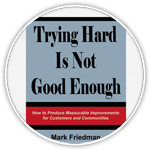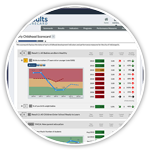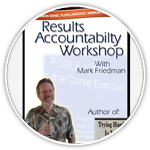COLLECTIVE IMPACT USING RBA
Collective Impact and RBA are a perfect fit. The idea of working together to produce community “impact” is at the heart of both bodies of work. And RBA compliments Collective Impact in other ways. Collective Impact literature sets out conditions for the success of community change efforts, and RBA provides specific methods to help partners meet those conditions. More and more places are describing their work in terms of implementing Collective Impact using RBA. The following summary addresses how communities can use RBA to meet the five conditions for Collective Impact set out by John Kania and Mark Kramer in their article Collective Impact, Stanford Social Innovation Review (Winter 2011).
Condition 1) A common agenda: Since Collective Impact is principally about community or population-level change, the idea of a Collective Impact agenda is first and foremost about population quality of life ambitions the community hopes to achieve. RBA provides a way to articulate such ambitions (or population results) such as “All children are born healthy. All children are ready for school. All families are safe and supportive. A clean and sustainable environment. A prosperous and inclusive economy.” For each population result, RBA provides a method to select the most important indicators that tell us the extent to which a given population result is being achieved, e.g. the percentage of low birth-weight births. These measures are displayed as baselines with history and forecast, with success defined as “turning the curve.” A Collective Impact agenda can address both population results and the priority indicator curves to turn. (A second meaning for agenda has to do with the idea of an action agenda, addressed below under “mutually reinforcing activities.”)
Key Points:
a. RBA provides clarity about the difference between improving population quality
of life and improving program performance.
b. Collective Impact agendas can take the form of priority population results (e.g. All
children born healthy) and priority indicator curves to turn (e.g. percentage of low
birth-weight births).
Condition 2) Shared measurement system: Measurement systems are needed at both the population and performance levels. RBA provides a way to categorize measures into population indicators and three types of performance measures (How much did we do? How well did we do it? Is anyone better off?). RBA also provides a method for setting measurement priorities in the form of a three part list: 3 to5 Headline measures (the best of what we currently have data for), Secondary measures (all other measures for which we have data), and a Data Development Agenda (a prioritized list of where we need new or better data). Population and performance measurement systems should be shared with the community on line. The Results Scorecard provides a tool for managing such complex data sets across communities and across partner organizations. This in turn allows for the creation of a community progress report on quality of life and the development of concise performance reports for programs.
Key Points:
a. RBA provides methods for identifying measurement priorities at both the population
and performance levels.
b. These priorities can be used to create a population quality of life report card and
program performance reports.
c. The Data Development Agenda allows partners to get new and better data over time.
Condition 3) Mutually reinforcing activities: Change is only possible at the community level if the partners are all pulling in the same direction. This involves agreement on strategies that will have the greatest impact, and action plans to make those strategies a reality. The RBA Turn the Curve process provides a readily understandable process for creating strategies and developing action plans. This process progresses from ends to means through 7 Questions that vary slightly for Population and Performance Accountability. (The 7 Population Accountability questions are shown at right.) The simplest version of this process, the Turn the Curve Exercise, can be completed in an hour. This way of thinking provides a structure for systematically improving strategies and action plans over time. RBA also encourages groups to go beyond planning for incremental change to the more challenging “what would it take?” questions, such as “What would it take for ALL children to succeed in school?” (See the work of Geoffrey Canada.)
Key Points:
a. RBA provides a method for creating strategies and action plans.
b. This allows partners to see how their actions can work together to create impact/improvement on
important population results and indicators
c. RBA encourages partnerships to go beyond incremental change to consider “what would it take?”
Condition 4) Continuous communication: The very definition of communication is about understanding what others are saying. Yet, the history of this work, at both the population and performance levels, is one of jargon and confusion. RBA uses plain language descriptions of the core set of ideas necessary to turn curves. RBA encourages the disciplined use of this language by all partners, enabling them to work together more effectively. And RBA methods promote get-to-the-point communications that are more likely to be read and used.
Key Points:
a. RBA uses plain language descriptions of core ideas to replace current confusing jargon.
b. The disciplined use of RBA common language enables partners to work together more effectively.
c. RBA language discipline, with turn the curve thinking, provide a structure for communication that
will be understood and used.
Condition 5) Backbone support organization: Community level or population level change requires support for functions that span across traditional organizational boundaries. Support can be lodged in a single organization or shared by multiple organizations provided that all necessary functions are covered. RBA can help identify the cross-community functions that require organizational support, including staffing the partnership, managing measurement systems, publishing reports, and keeping track of plans and action commitments. A support organization can also serve to facilitate “neutral” Turn the Curve conversations for community partners.
Key Points:
a. RBA can help identify cross-community functions that require special organizational support.
b. RBA can be used to make the case for funding the partnership’s plans and the organizational
capacity necessary to support effective working together.
For more information see “Achieving ‘Collective Impact’ with Results-Based Accountability™,” Deitre Epps, Results Leadership Group, 2011 (available on resultsaccountability.com and resultsleadership.org)
Mark Friedman April, 2014



